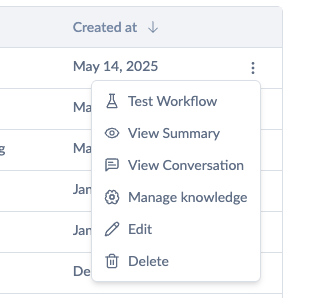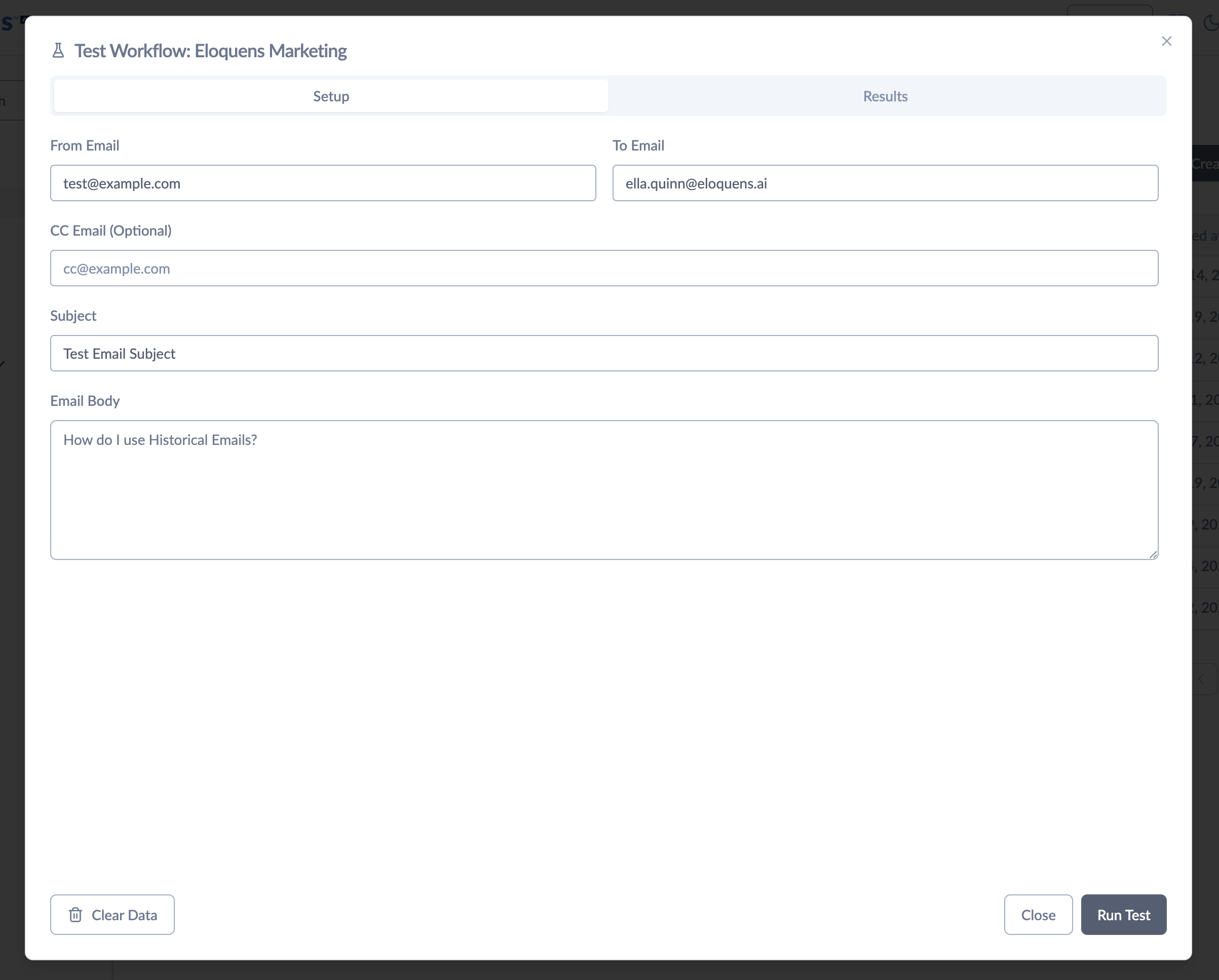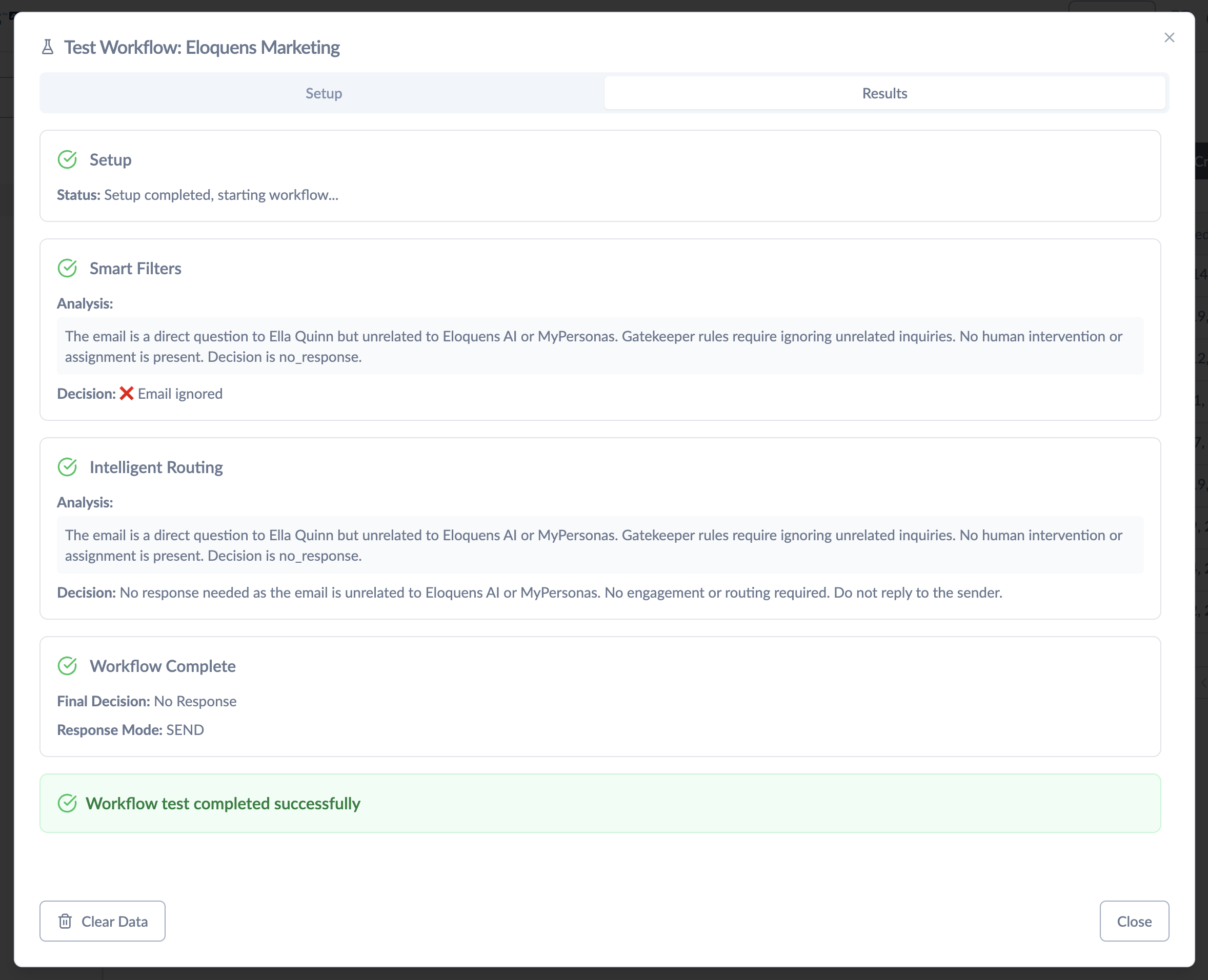Overview
The Test Workflow feature enables you to:
- Validate workflow logic with custom test emails before going live
- Debug configuration issues in a safe environment
- Preview AI responses and routing decisions
- Ensure proper setup of all workflow components
- Test different scenarios with various email types and content
⚠️ Important: Each test workflow run utilizes 1 email processing quota from your subscription plan, the same as processing a real email.
Accessing Test Workflow
From Workflow Management
- Navigate to Workflows in the main menu
- Find your workflow in the list or grid view
- Click the "Test" button on your workflow row
- The Test Workflow dialog will open
Test Workflow Interface
The Test Workflow dialog opens with a clean, focused interface featuring two main tabs:
Setup Tab
The Setup tab is where you create your test email that will be processed by your workflow.
Email Form Fields
Create a realistic test email using these fields:
From Email (Required)
- Purpose: The sender's email address
- Default:
test@example.com - Best practice: Use a realistic sender address that matches your expected email sources
To Email (Required)
- Purpose: The recipient's email address
- Default: Pre-filled with your workflow's email persona address
- Best practice: Use the actual email address your workflow monitors
CC Email (Optional)
- Purpose: Carbon copy recipients
- Usage: Test how your workflow handles CC'd emails
- Best practice: Leave blank unless testing CC-specific logic
Subject (Required)
- Purpose: Email subject line
- Default: "Test Email Subject"
- Best practice: Use subjects that match real emails your workflow will process
Email Body (Required)
- Purpose: The main email content that your workflow will analyze
- Default: "This is a test email to validate the workflow functionality."
- Best practice: Use realistic content that represents actual emails you expect to receive
Results Tab
The Results tab shows live streaming results as your workflow processes the test email.
Live Execution Monitoring
Watch your workflow execute in real-time through streamed updates that appear instantly:
- Setup: Workflow initialization and preparation
- Smart Filters: Gatekeeper filtering decisions and logic
- Knowledge AI: Knowledge base search and content retrieval
- Connections: External system integrations and data fetching
- Historical Search: Previous conversation analysis and context
- Intelligent Routing: Orchestrator routing decisions and reasoning
- Response: AI response generation and content creation
- Response Draft: Draft email creation (if workflow configured for drafts)
- Routing Draft: Routing notification drafts
- Workflow Complete: Final execution status and summary
Phase Result Details
Each workflow phase displays:
Success Indicators
- Green checkmark: Phase completed successfully
- Execution time: Duration the phase took to complete
- Phase results: Detailed output and decisions made
- Generated content: Any content created (responses, routing decisions, etc.)
Failure Indicators
- Red X mark: Phase failed to complete
- Error message: Specific error details and description
- Troubleshooting guidance: Suggestions for resolving issues
- Impact assessment: How failures affect subsequent phases
Running a Test
Starting the Test
- Complete all required fields in the Setup tab
- Review your test email for realism and relevance
- Click "Run Test" button at the bottom of the dialog
- Automatically switches to Results tab to show progress
- Watch live streaming results as each phase executes
Monitoring Progress
During test execution:
- Real-time updates: Results stream in as each phase completes
- No page refresh needed: Updates appear instantly
- Cannot be cancelled: Tests run to completion once started
- Clear progress indication: Visual feedback on current phase
- Detailed logging: Comprehensive information for each step
Understanding Your Results
Successful Test Run
- All phases green: Workflow executed without errors
- Generated response: AI created an appropriate reply
- Proper routing: Email was correctly categorized and handled
- Expected behavior: Workflow performed as configured
Partial Failures
- Some phases failed: Identify specific configuration issues
- Error isolation: See exactly where problems occurred
- Downstream impacts: Understand how failures affect later phases
- Actionable feedback: Clear guidance on what needs fixing
Complete Failure
- Early phase failure: Workflow stopped due to critical error
- Root cause identification: Pinpoint the source of problems
- Configuration review needed: Check workflow setup and connections
- Support guidance: Information to help resolve complex issues
Best Practices
Creating Effective Test Emails
Realistic Content
- Use actual customer language: Copy real email examples (remove sensitive data)
- Test various scenarios: Different question types, urgency levels, languages
- Include edge cases: Unusual requests, unclear intent, multiple questions
- Match your domain: Use email addresses and content relevant to your business
Comprehensive Testing
- Test different email types: Inquiries, complaints, requests, follow-ups
- Vary email length: Short messages, detailed requests, multi-paragraph emails
- Test different senders: New customers, existing clients, internal staff
- Include formatting: HTML emails, plain text, emails with attachments mentions
Workflow Validation Strategy
Pre-Launch Testing
- Test basic functionality: Ensure all phases execute successfully
- Validate Smart Filter logic: Confirm proper email categorization
- Check response quality: Review AI-generated responses for accuracy
- Verify routing decisions: Ensure emails route to correct handlers
- Test knowledge integration: Confirm relevant knowledge is retrieved
Iterative Improvement
- Test after configuration changes: Validate updates before going live
- Regular testing: Periodic tests to ensure continued functionality
- Scenario expansion: Add new test cases as you encounter new email types
- Performance monitoring: Track execution times and identify bottlenecks
Resource Management
Quota Awareness
- Each test counts: Every test run uses 1 email processing quota
- Plan accordingly: Balance testing needs with quota limits
- Efficient testing: Create comprehensive test emails to maximize value
- Monitor usage: Track quota consumption in your account dashboard
Strategic Testing
- Test critical changes: Always test after major configuration updates
- Batch related tests: Group similar test scenarios together
- Document results: Keep records of successful test configurations
- Share learnings: Document best practices for your team
Troubleshooting Common Issues
Setup Problems
Form Validation Errors
- Missing required fields: Ensure all required fields are completed
- Invalid email formats: Use properly formatted email addresses
- Empty content: Provide meaningful subject and body content
- Special characters: Some special characters may cause parsing issues
Data Not Saving
- Browser storage: Ensure your browser allows local storage
- Private browsing: Test data may not persist in incognito mode
- Browser cache: Clear cache if experiencing data persistence issues
Execution Failures
Smart Filter Failures
- Review filter configuration: Check gatekeeper rules and logic
- Test email content: Ensure content matches filter expectations
- Keyword matching: Verify required keywords are present
- Decision logic: Review filter decision trees and conditions
Knowledge AI Issues
- Knowledge base setup: Verify knowledge AI is properly configured
- Content availability: Ensure relevant knowledge exists for test topics
- Search functionality: Check that knowledge search is working
- Connection status: Verify knowledge AI connections are active
Routing Issues
- Routing rules: Review orchestrator routing logic and rules
- Handler availability: Verify routing targets are properly configured
- Decision criteria: Check that routing conditions are met
- Fallback handling: Ensure proper fallback routing is configured
Response Generation Problems
- Response templates: Ensure response generation is properly configured
- Tone settings: Verify response tone and style configurations
- Context availability: Check that sufficient context is available for responses
- AI model access: Ensure AI response generation services are accessible
Conclusion
The Test Workflow feature is an essential tool for ensuring your Eloquens AI workflows perform correctly before handling real customer emails. By creating realistic test scenarios, monitoring detailed execution results, and iteratively improving your configuration, you can build confidence in your workflow's ability to handle real-world email processing.
Remember that each test run uses 1 email processing quota from your subscription, so use testing strategically to maximize the value of your quota while ensuring thorough validation of your workflow configuration.
Start with simple test emails to validate basic functionality, then gradually increase complexity to test edge cases and ensure robust performance across all scenarios your workflow might encounter.



Douglas Ho
Comments